How did a single game lead to the shake-up of an entire industry, and sounded the death knell of an entire corporation?
We talk about Intel and AMD in the CPU industry all the time, but there was another competitor in the party. Until id Software’s Quake moved things around for this third participant.
Note: That was the last of the low-effort Quake puns in the article
When computers were actually stuff that only academics and dedicated enthusiasts (which are both polite terms for nerds) would talk about and tinker with, there used to be a lot of inconsistency in how and what software worked with your hardware, and even differences in a singular component could mean a really, really hard time for someone who wanted to use it on the computer with that unintentional anomaly. In a nutshell, nothing was really user friendly, and we’ve come really, really far in terms of making everything “just work”, even if there are many examples where you may not feel like so. We can talk about computers and have a proper discussion about building one on our own, without having actual hands-on experience doing something like it. I personally never have built a PC, but can guide anyone with a reasonable degree of knowledge about what to look, what to buy and how to go about making reasonable purchase choices and so on, for an instance of this democratisation of knowledge. And in this story, I describe how that kind of inconsistency led to a whole corporation slipping out of relevance, and eventually fading away.

Who were they, then?

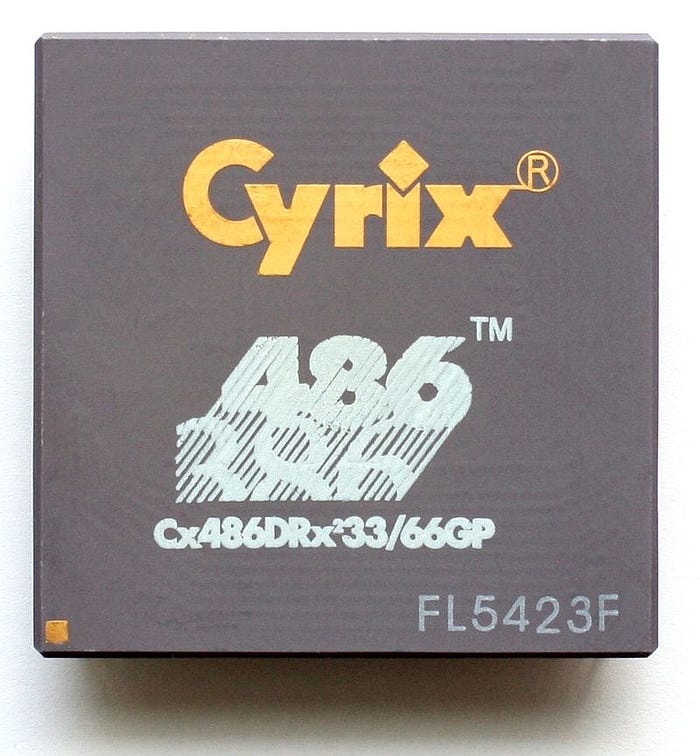
I realise that I have still not even mentioned the corporate in question: Cyrix. Cyrix was formed in 1988 by Tom Brightman and Jerry Rogers, primarily as a supplier specifically for math coprocessors, which were implemented alongside a conventional processor for dedicated tasks. They did not make a shift to actual processors until 1992, with their first processor, Cyrix Cx486, which was named a little misleadingly, as it wasn’t actually a 486 processor, rather a 386 with some additional performance benefits over an old (at that time) 386 chip. 386 and 486 refer to the 3rd and 4th evolutions of the Intel 80x86 chips respectively. Yes, Intel wasn’t particularly enthusiastic with their naming schemes back then. But they eventually got that right, which is also important to the Cyrix story, but a little later. Now the Cx486 was not really well-reviewed by critics of that time, because of its obvious naming anomaly. And Cyrix responded to that, by marketing subsequent versions which were improvements over the original design, exclusively as 386-to-486 upgrade packages, as shown in these pictures.
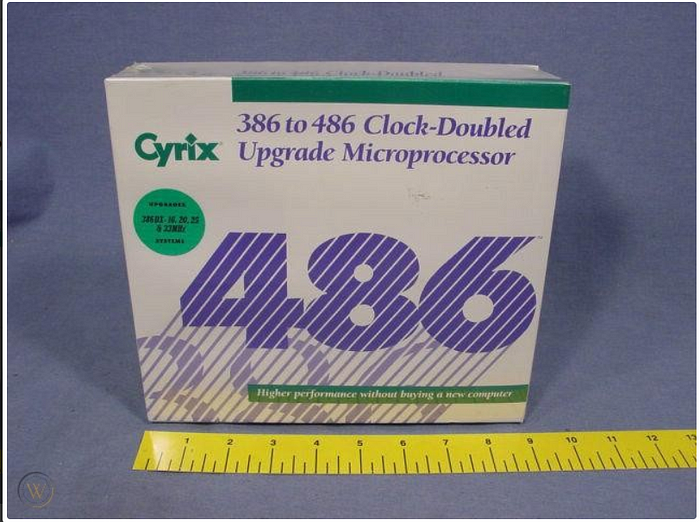
Cyrix had tried to occupy a niche here. It made its way into the minds of people who wanted to upgrade their system, but didn’t have the money to throw at a new generation of Intel processors, which were again being manufactured by a whole troupe of license-holders for Intel, as “silicon” (silicon in computing terms usually refers to a chip ready to be used in a system as a processor, and not necessarily just the 14th element of the Periodic Table, which is the chief material of the internals of a CPU) manufacturing was a nascent industry, and supply disruptions could be countered by system builders by sourcing processors from more than one such manufacturer. Chief among these licensees was AMD, who also played a key role in Cyrix’s journey.
Cyrix concluded their line of 486 clones with actual 486-compatible chips to compete with AMD and Intel’s offerings, but with a late arrival, and a performance penalty as observed by benchmarking, they, again, found the budget and upgrade market niche. AMD had succeeded in getting their chips shipped in pre-built new systems from Compaq and Acer, but Cyrix failed in doing so. It has been lucrative to this very day for processor manufacturers to make sure their products finds the pre-built market as that segment of the market has far more relevance and buyer base than the enthusiasts. Think about it this way: You would much rather have a whole PC running out-of-the-box if you are buying it new than assemble it yourself, unless you are an enthusiast, which is a minority of users. That is why, getting PC manufacturers’ support has always been key for chip makers. AMD’s success in this in this particular instance is also quite ironic in hindsight as they will fall victim to this exact problem some years down the line, as I wish to explore in a different article. But for now, Cyrix was a niche maker of cheaper chips for the people who would bother to upgrade their existing systems over buying an entirely new one. And unfortunately, it is not an enviable position to be in, no matter how much praise they will get from their (small) user base. They always will be the vocal minority, and yet again this part draws parallels with AMD’s adoption struggles amongst a wider audience. But that’s another story for another day.
Gen 5: Pentium® (and its clones for company)

Pentium ushered in the next era of PC, it was the first time we had a trademarked name instead of confusing numbers to distinguish between different generations of x86 processors. It was Intel’s way of standing out from the crowd, as previously, 486 clones were haphazardly called “__486” by the whole spectrum of chip makers, as Cx486 by Cyrix and Am486 by AMD and so on. With a trademark, Pentium was Intel’s offering, separate from the rest. Pentium was Intel, and Intel was Pentium, as far as the identity of the brand names went.
This naming grandiosity didn’t quite change a lot of other things, though. Other manufacturers still released their own chips that were alternatives to P5 (which is the microarchitecture behind this first Pentium chip, as the Pentium name lives on till this day, but with a vastly evolved… everything really). AMD made their K5, which also was competition for the Pentium, but Intel’s offering was still quite superior in performance. So what did Cyrix do in this newer era of chips?
They did what they had done before: their Cx586 released before the Pentium was ready to ship, and was again a supposed upgrade path for older 486 systems, and Cyrix had again managed to get some Pentium-like features on these chips. This was an intermediate step taken in early 1995, but Cyrix’s best was yet to come, just later that year.
6x86, id Software and Quake (with a trip to the archives of Usenet)
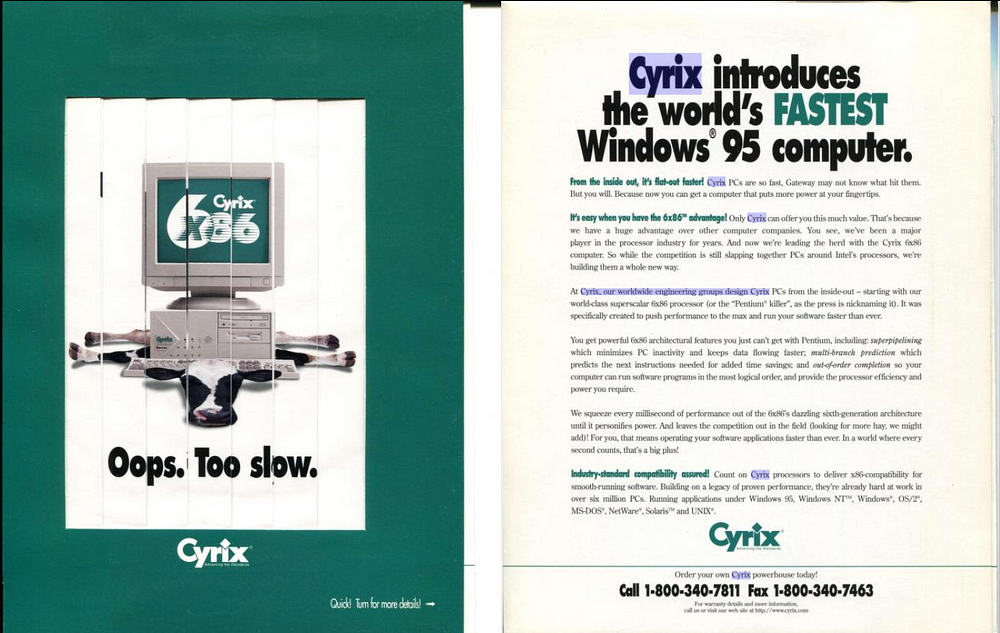
Cyrix’s most notable chip was the 6x86, a Pentium-compatible chip released in 1995. The competition at that time between the P5 Pentium and the 6x86 was intense, and many, many critics and benchmarks alike demonstrated the two chips trading blows amongst each other for different use cases.
Cyrix’s rejuvenated 6x86 handily beats a comparable Pentium, has no trouble with 16-bit code, and boasts the fastest I/O bus in the business. However, Cyrix can’t match Intel’s fastest core speeds, and the 6x86 doesn’t support MMX.
-BYTE Magazine, November 1996 (Vol 21, №11), “The x86 Gets Faster With Age”

However, the main story that is associated with the 6x86 revolves a lot around Quake. A certain crowd of people which is a collection of older (fine, older than me) computer enthusiasts and retro gaming enthusiasts would recognise this game, as a hotly-anticipated release from developers id Software, who were, and still are highly regarded as the developers of the Doom and Wolfenstein series of games. At that time, Quake was another entry into id’s growing list of stellar titles, so the anticipation for it was quite high. Released first in June 1996, some Quake players got around 15 frames a second consistently, desipte having Pentium-compatible processors that were able to go toe-to-toe with their competitors, which ran the game just fine and at a playable frame rate. All these players, were users with 6x86 chips.
A small amount of Googling led me to the group comp.sys.ibm.pc.games.action on Usenet*, where multiple threads (1 2 and my favourite 3) opened just in the first week of July, 1996, with users mentioning having a 6x86, and getting sub-par framerates in Quake, and Quake in particular, regardless of their other peripherals, including their video cards. In every single case, at every single resolution, Quake was simply unplayable owing to that terrible framerate, even at a lower resolution. What was the reason for this? Was Quake biased against Cyrix chips for some reason? Actually, yes, in a way.
*Usenet has since been archived by Google in Google Groups. And that is why there are threads on a Google-run website apparently from 1996 or so, which predate the founding of Google itself.
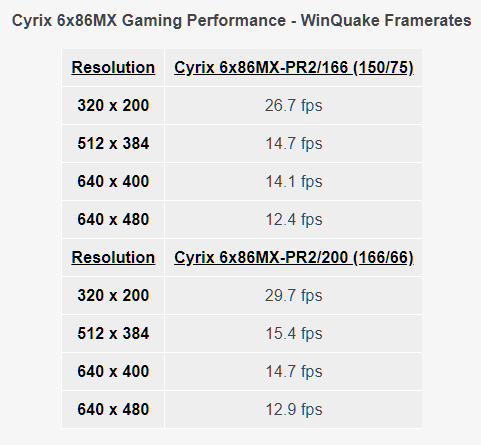
In the mid-90s, the direction in which chip design would go in the future was not as clear as it is right now. This was to be determined by the code that would be run on these chips, the programs that it would run, and how it will process these tasks. This relation between the hardware of the system and the software that will run on it is the essence of computer architecture, and precisely what it seeks to study. So, in this climate of some uncertainty, it was a challenge to predict what aspects of their chip design should be prioritised and what shouldn’t. Hence, the 6x86 was a very different chip from the Pentium it stacked up against, and while Cyrix enjoyed the initial successes they saw, when their chips outperformed the Pentiums that ran at a similar or higher speed as compared to the 6x86, they also lagged far behind in other features.

The star feature, or design flaw here, was the lack of instructional pipelining in the Cyrix product. Pipelining is a technique now integral to microprocessors, which divides all tasks into a set of smaller micro-operations. These micro-operations then are executed individually by certain parts of the processor, simultaneously. This makes operations more efficient as there is no chance for one part of the processor to be idle, as it will simultaneously be doing something while other parts do other tasks. This proved to be a grave oversight on Cyrix’s part, as Quake used the Pentium’s FPU (Floating-point Unit) to calculate and place object textures in-game. This FPU, was pipelined. Thus, the 6x86 could not handle these calculations in the same manner and with the same speed as the Pentium. This problem was easy to resolve, but it was incumbent on id Software to provide the solution to it by having a toggle for it in the game’s settings, but they skipped it completely unlike other developers. Due to id’s pedigree, Quake was a huge deal, a top-shelf game, and Cyrix was unable to get it to work on their systems. Even that was not all; Quake was designed with a heavy focus on Pentium systems, and it conformed to the quirks of the Pentium architecture while streamlining other optimisations that would have benefitted any othe competitor. All P5 processors were now underneath Pentium in terms of performance with Quake, and Cyrix’s approach with the 6x86 caught them particularly badly. Their anemic FPU was inept at texture mapping, and the game was unplayable on their systems.
The term “unplayable” gets bastardised a lot and thrown about like it is a proxy for “just about acceptable” in gaming circles, but this was clearly more serious than that. More importantly, it was Quake of all games that had shown this issue, not any other game which would have less eyeballs on it at the time. So what were the consequences of this shortcoming for Cyrix and their 6x86?
The Aftermath
Cyrix had its credibility as a manufacturer of products helpful for the gaming community wiped out. And understandably so, their product was just incapable of handling tasks like those. Cyrix had predicted software development to go one way, where they put out a much better performance as compared to Intel’s offering. But Quake demonstrated that it is a detrimental strategy, and the already-struggling but promising Cyrix had lost another battle.
Something I had to gloss over in its entirety in this article is the series of litigation that Intel and Cyrix went through against each other, but the brief here is that Intel was already significantly larger in capacity, market share and budget than Cyrix, and several of the lawsuits that was filed against Cyrix were more often than not just a struggle for Cyrix to endure so as to make them lose financial power to legal costs. A successful range of products would have allowed them to get out of the troubles, but the 6x86 made sure that it did not happen. Ultimately, Cyrix ended up shifing focus, until it would vanish from the technology space for good.
The Later Years
“National Semiconductor Corp’s decision to acquire Cyrix Corp. is a sign of growing consolidation among chip makers which may mean greater competition for Intel…”
-Computerworld, August 4, 1997
This was an incorrect prediction.
Cyrix’s last products before their merger with National Semiconductor in 1997 were the MediaGX and its iterations. These were neither competition to Pentium, nor were they even standalone CPUs. They were supposed to be substitutes for multiple singular components of a computer on one chip, similar to SoC’s (System-on-Chip) of today. They saw some success in these, with Compaq implementing them in their lowest-cost Presario computers. Interestingly, this success saw some manufacturers also buying 6x86’s from Cyrix once again as they had regained some mind-share in their view because of the MediaGX chips. But their shift from the top-end, the cutting edge, to solely making entry-level products is something we would see again in the future, when AMD struggled against a resurgent Intel in the early 2010s, but before seeing a massive breakthrough in 2017. Cyrix did not see that happen to them, and merged with National Semiconductor as they were producing the first MediaGX chips.
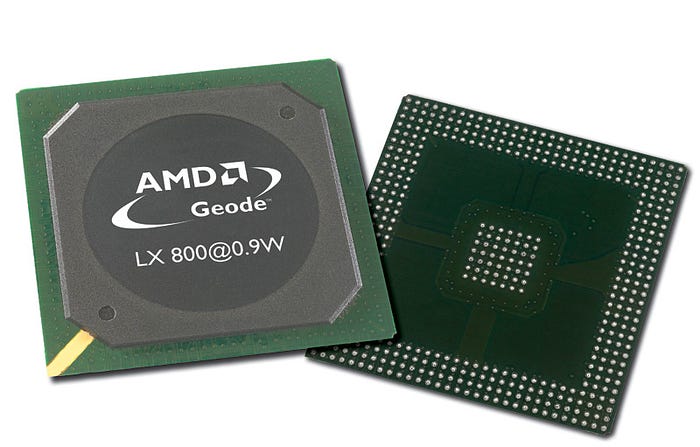
This merger lost Cyrix the last of their promise: their design team. National Semiconductor had greatly mismanaged the merger, and let alone a comeback, retaining Cyrix’s original position in the space had become an impossibility for them. Ultimately, Cyrix was sold again to VIA Technologies, at which point they were developing their final x86 product, the “Geode” core. It was a low-power consumption processor core, which was further sold to AMD in 2003. Geode was in production all the way until 2019, and also was the basis for the world’s lowest power x86 processor, demonstrated by AMD in 2006. The longevity of Geode and its technical achievements such as its demonstrably high versatility is an instance of Cyrix’s ingenuity in action, even in the worst times for their brand.
I want to make a distinction here: Although Cyrix had a combination of problems that it went through before their folding, the Quake debacle still stands out as it was something quite out of left-field for Cyrix. It was a game developer that had chosen to take a certain strategy to game development, and it cost Cyrix, who were already suffering due to lawsuits, and caught in a market share battle against giants such as Intel and AMD. All of these factors led to Cyrix’s downfall, but the Quake problem still stays quite a unique one in this industry. There has been software that has favoured one brand more than others since then as well, but they have either been significantly smaller in user base, or the gap between competitors is not too detrimental for the trailing party. Quake was none of those things, unfortunately.
Intel vs. AMD, a rivalry since the 20th Century.
By the time Cyrix had disappeared from the top, Intel and AMD were caught in the “gigahertz war”, a name given to Intel and AMD’s leapfrogging each other with product releases that beat the competitor’s clock speed, in a race to see who gets to 1 GHz first. AMD won that with their Athlon chip in the year 2000. Since then these two have enjoyed periods of dominance over the other, with Intel usually having an upper hand whilst being the centre of either lawsuit filings or security flaws, and AMD having an upper hand for relatively shorter periods of time. Both of these share a market space that is dominated by them, and them only, by using cross-licensing agreements that help keep the x86 CPU market blocked for entry by any other aspiring manufacturer, something that I also have written about.
